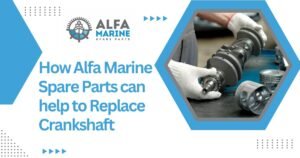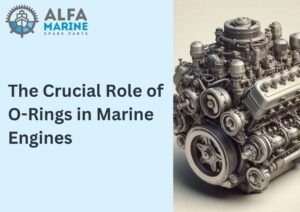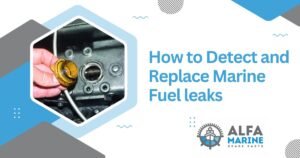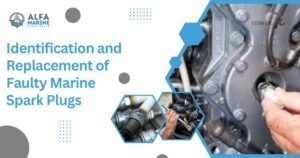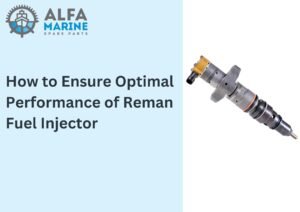Welcome aboard Alfa Marine Spare Parts, your trusted ally for all marine equipment needs. Here at Alfa Marine, we specialize in delivering top-notch, genuine marine parts and equipment at competitive market rates.
In the dynamic landscape of engine performance and maintenance, monitoring cylinder head temperature reigns supreme. This pivotal metric directly impacts engine health, representing the temperature of the cylinder head in an internal combustion engine.
In our latest blog post, we embark on a journey into the realm of marine engine cylinder heads. We’ll explore their significance, dissect key components, and illuminate their pivotal role in propelling marine vessels forward.
Join us as we navigate the intricate world of cylinder heads, uncovering their indispensable contribution to the performance of marine engines.
What is Cylinder Head Temperature?
The cylinder head serves as a critical component of an engine, housing the combustion chamber, valves, and in many cases, the camshaft(s).
As the engine operates, combustion occurs within the cylinder, generating intense heat. The cylinder head’s primary function is to manage this heat by dissipating it efficiently to prevent overheating, which can lead to engine damage or failure.
Demystifying Prime Cylinder Head Components in Marine Engines
Cylinder heads in marine engines play a pivotal role in the combustion process, housing essential components that ensure optimal performance and reliability.
Understanding these prime components is crucial for marine engineers and enthusiasts alike. So, let’s delve into the key components that constitute a marine cylinder head:
Fuel Injector
The fuel injector is a precision-engineered component responsible for delivering pressurized fuel into the combustion chamber.
So, equipped with a spring-loaded needle valve, it opens under pressure, allowing fuel to enter the chamber at high speed and pressure, essential for efficient combustion.
Inlet and Exhaust Valves
Inlet and exhaust valves are critical for regulating the flow of air and exhaust gases in and out of the combustion chamber.
Crafted from specialized alloys, the inlet valves withstand low temperatures, while the exhaust valves are designed to endure extreme heat, pressure, and stress.
Cylinder Relief Valve
The cylinder relief valve serves as a safety mechanism, releasing excess pressure from the combustion chamber when it exceeds normal levels.
This action helps prevent damage to the engine components due to overpressure situations.
Valve Rotators/Spinners
Valve rotators or spinners play a vital role in maintaining valve efficiency by eliminating carbon deposits on the valve seat.
However, beyond emission control, they serve as a safety measure to prevent potential fire hazards on the valve seat and face.
Valve Seats
Valve seats ensure a secure seal between the valve and the intake/exhaust ports when the engine is not in operation.
This sealing action is crucial for maintaining compression and preventing leakage during combustion.
Inlet and Exhaust Valve Inserts
Inlet and exhaust valve inserts facilitate the passage of air-fuel mixture into the combustion chamber and the release of exhaust gases, respectively.
Basically, these inserts are integral components of the cylinder head, optimizing engine performance and efficiency.
Fuel Injection Valve
Housed within the cylinder head, the fuel injection valve plays a pivotal role in the combustion process. Positioned on an interchangeable sleeve, it sprays a mist of high-pressure air and fuel mixture into the cylinder, ensuring efficient combustion and power generation.
Moreover, it is essential to understand these prime cylinder head components for marine engines to run smoothly.
By recognizing their functions and significance, marine engineers can effectively maintain them. And troubleshoot engine systems to keep vessels operating at peak performance levels.
Factors Affecting Cylinder Head Temperature:
Engine Load and RPM: Higher engine loads and RPMs typically result in increased combustion and friction, leading to elevated cylinder head temperatures.
Cooling System Efficiency
The effectiveness of the engine’s cooling system, including the radiator, water pump, and coolant, directly influences cylinder head temperature regulation.
Air/Fuel Mixture:
A lean air/fuel mixture can lead to higher combustion temperatures, potentially elevating cylinder head temperature.
Engine Design and Materials:
Modern engines are designed with advanced materials and cooling technologies to optimize heat dissipation and manage cylinder head temperature more effectively.
What Causes a Cracked Cylinder Head?
Several factors can contribute to a cracked cylinder head, including:
Overheating:
Excessive heat can cause thermal expansion and stress on the cylinder head, leading to cracks.
Coolant Contamination:
Corrosion caused by coolant contamination can weaken the cylinder head, making it more susceptible to cracking.
Irregular Installation or Torque: Incorrect installation or improper torque specifications during cylinder head installation can result in stress concentrations and eventual cracking.
Material Defects:
Manufacturing defects or flaws in the cylinder head material can lead to premature failure and cracking.
How Much Does it Cost to Have Cylinder Heads Resurfaced?
Cylinder head resurfacing is a crucial process that can significantly impact your engine’s performance and longevity. The cost of having cylinder heads resurfaced varies depending on factors such as the size and material of the cylinder head, the extent of damage, and the shop you choose. On average, you can expect to pay anywhere from $150 to $400 per cylinder head for resurfacing services.
When it comes to cylinder heads, maintaining an optimal temperature is key for proper functioning. The cylinder head temperature refers to the heat generated within the combustion chamber during engine operation.
Moreover, proper resurfacing helps ensure efficient heat dissipation, preventing overheating issues that could lead to costly engine damage.
The bent cooling fin on an aluminum cylinder head
A bent cooling fin on an aluminum cylinder head can be a cause for concern, as it can disrupt the airflow needed to dissipate heat effectively.
Cooling fins are designed to increase the surface area of the cylinder head, allowing heat to transfer away more efficiently.
Bent fins disrupt airflow, creating localized hot spots that may lead to overheating and potential engine damage.
Impact or Collision:
Accidental impact with objects or debris while operating the engine or during maintenance can bend cooling fins.
Improper Handling:
Mishandling the cylinder head during removal, installation, or transport can cause fins to bend.
Overheating:
In extreme cases of overheating, the expansion and contraction of metal may cause fins to warp or bend.
Implications of Bent Cooling Fins:
Reduced Cooling Efficiency: Bent fins disrupt the airflow over the cylinder head, reducing the cooling efficiency and potentially leading to scorching
Hot Spots: Areas with bent fins may experience inadequate cooling, resulting in localized hot spots that can cause thermal stress on the cylinder head.
Engine Performance: Over time, overheating due to bent cooling fins can degrade engine performance and efficiency, leading to increased fuel consumption and potential mechanical issues.
Repairing Bent Cooling Fins:
Gentle Straightening: Carefully straightening the bent fins using a soft mallet or pliers can sometimes restore airflow and cooling efficiency. However, caution must be exercised to avoid further damage.
Professional Repair: In cases of severe bending or damage, it may be necessary to seek professional repair or replacement of the cylinder head to ensure optimal cooling performance.
Preventive Measures:
Regular Inspection: Periodically inspecting the cylinder head for signs of bent or damaged cooling fins can help identify issues early and prevent potential overheating problems.
Safe Handling:
Handle the cylinder head with care during maintenance and installation to avoid bending or damaging the cooling fins.
Maintain the cooling system with regular checks, inspections, and cleaning, including checking coolant levels.
Addressing bent cooling fins promptly is essential to maintain optimal engine performance and prevent overheating-related issues.
By understanding the causes and implications of bent fins, engine operators can take preventative measures and address issues effectively. This will also ensure the longevity and reliability of their engines.
How to Repair a Cracked Cylinder Head?
Repairing a cracked cylinder head is a complex process that often requires the expertise of trained professionals. Depending on the severity of the crack and the engine’s design, repair options may include:
Welding:
Welding can be used to repair minor cracks in the cylinder head, but it requires precision and expertise to ensure proper sealing and structural integrity.
Cold Stitching:
This method involves drilling holes along the length of the crack and inserting metal pins to reinforce and also seal the crack.
Replacement:
In cases of severe damage or extensive cracking, replacing the cylinder head may be the most practical and cost-effective solution.
Frequently Asked Questions
What does cylinder head temperature do?
It serves as a key indicator of engine health. And performance, helping engineers assess combustion efficiency, cooling system effectiveness, and potential overheating issues.
Where is the cylinder head temp?
The cylinder head temperature is typically measured using a sensor installed in or near the cylinder head of an internal combustion engine.
Final Thought
Finally, understanding cylinder head temperature is crucial for maintaining engine performance and preventing costly damage.
The owner of an engine can prolong its life by monitoring temperature levels and addressing issues promptly.
So, consult a qualified mechanic or engine specialist if you encounter a cracked cylinder head.
Are you looking for genuine spare parts for cylinder heads?
Alfa Marine Spare Parts is the leading online store for reliable high-quality marine engines, spare parts, and ship accessories. So, contact us with the required part number. Our knowledgeable sales executives send a quote within 24 hours and ensure fast shipping.


